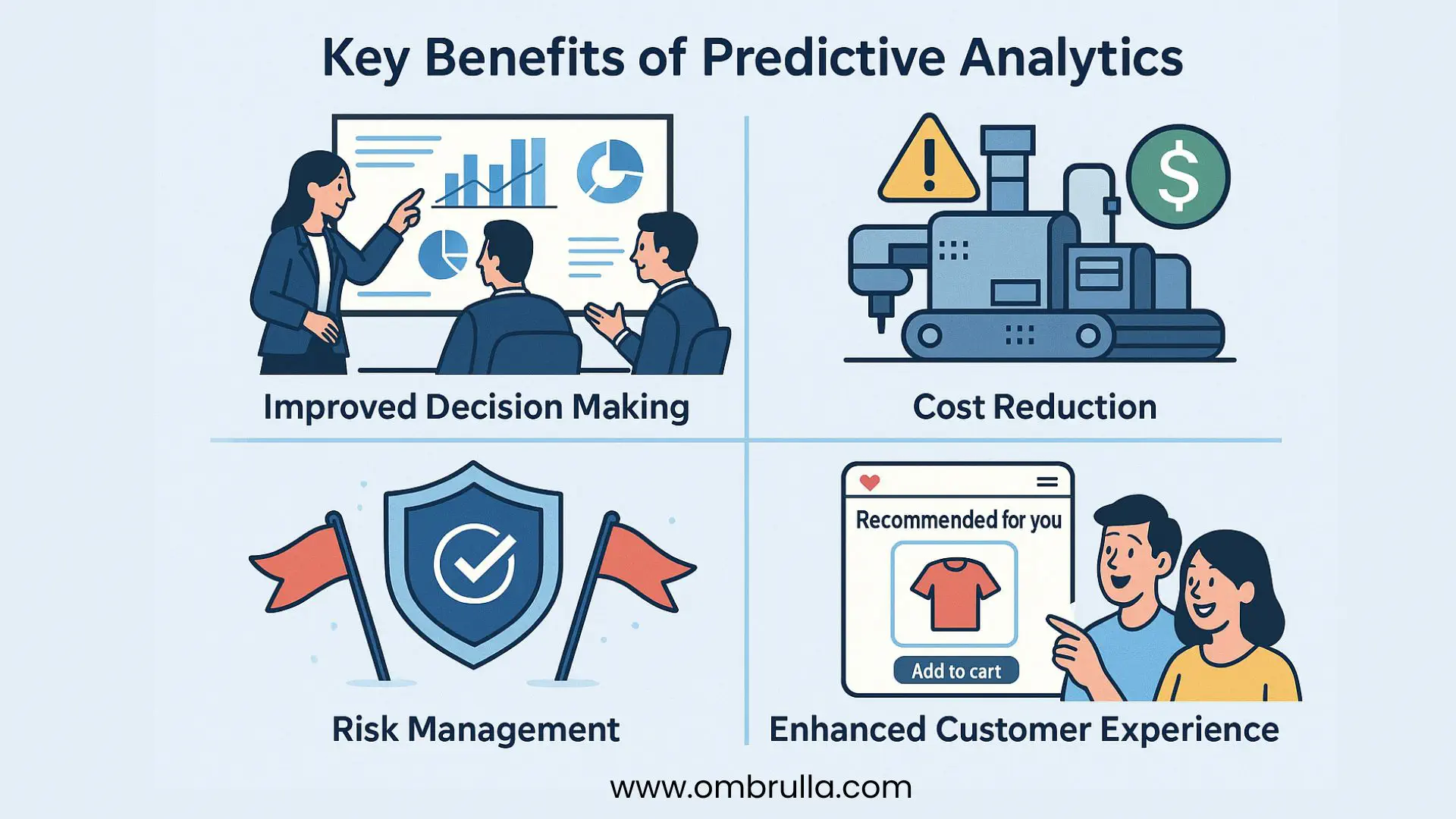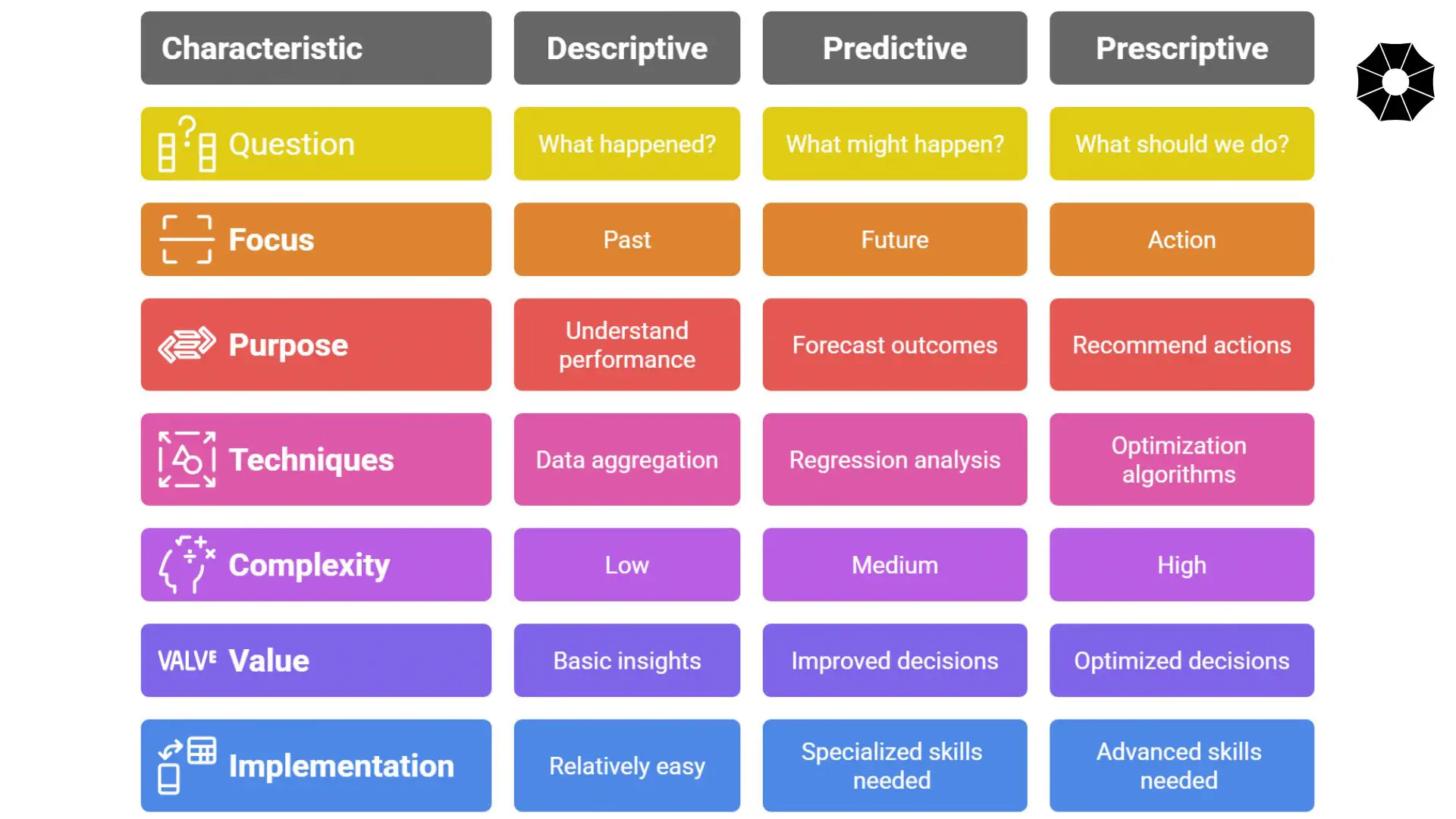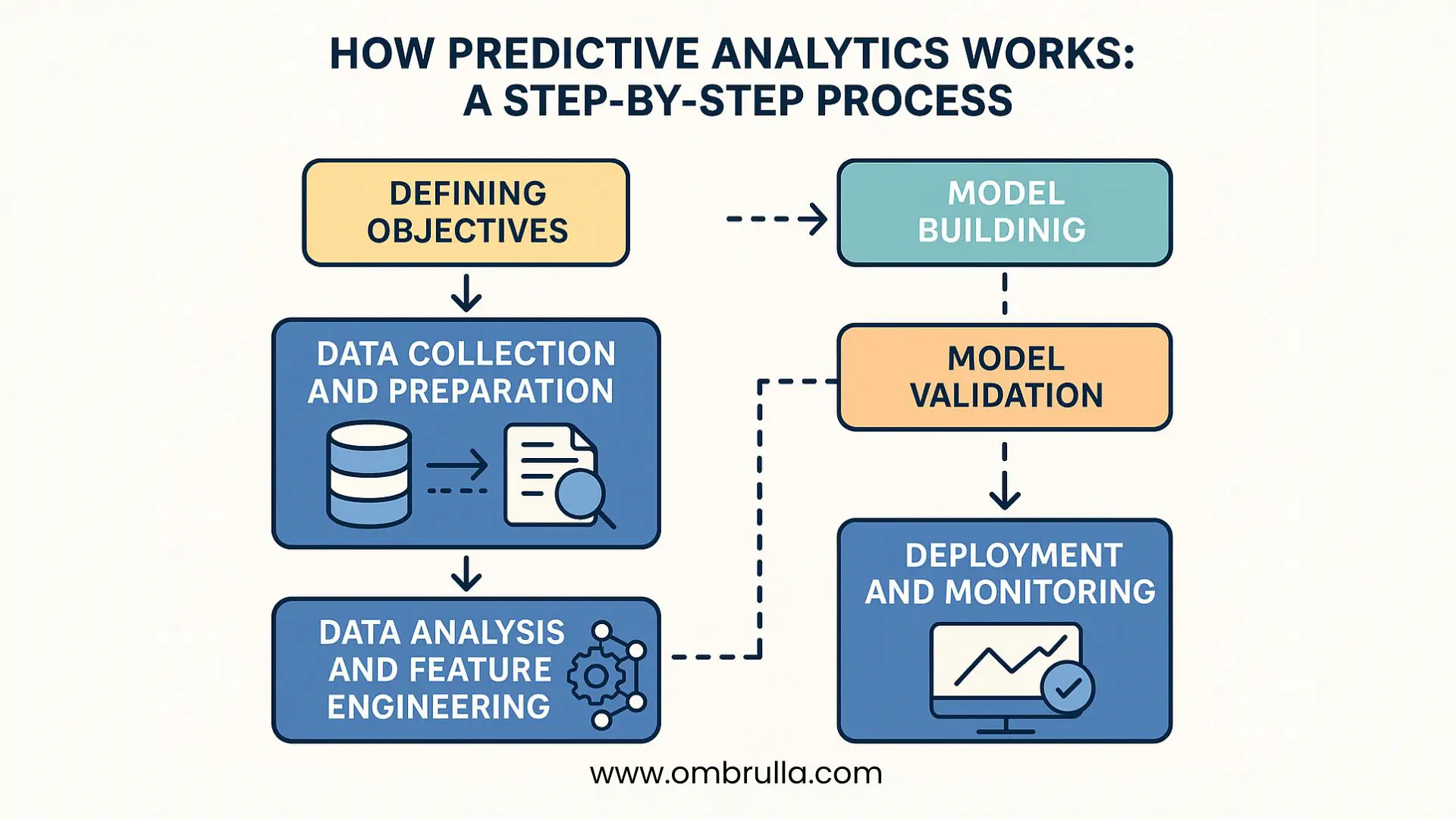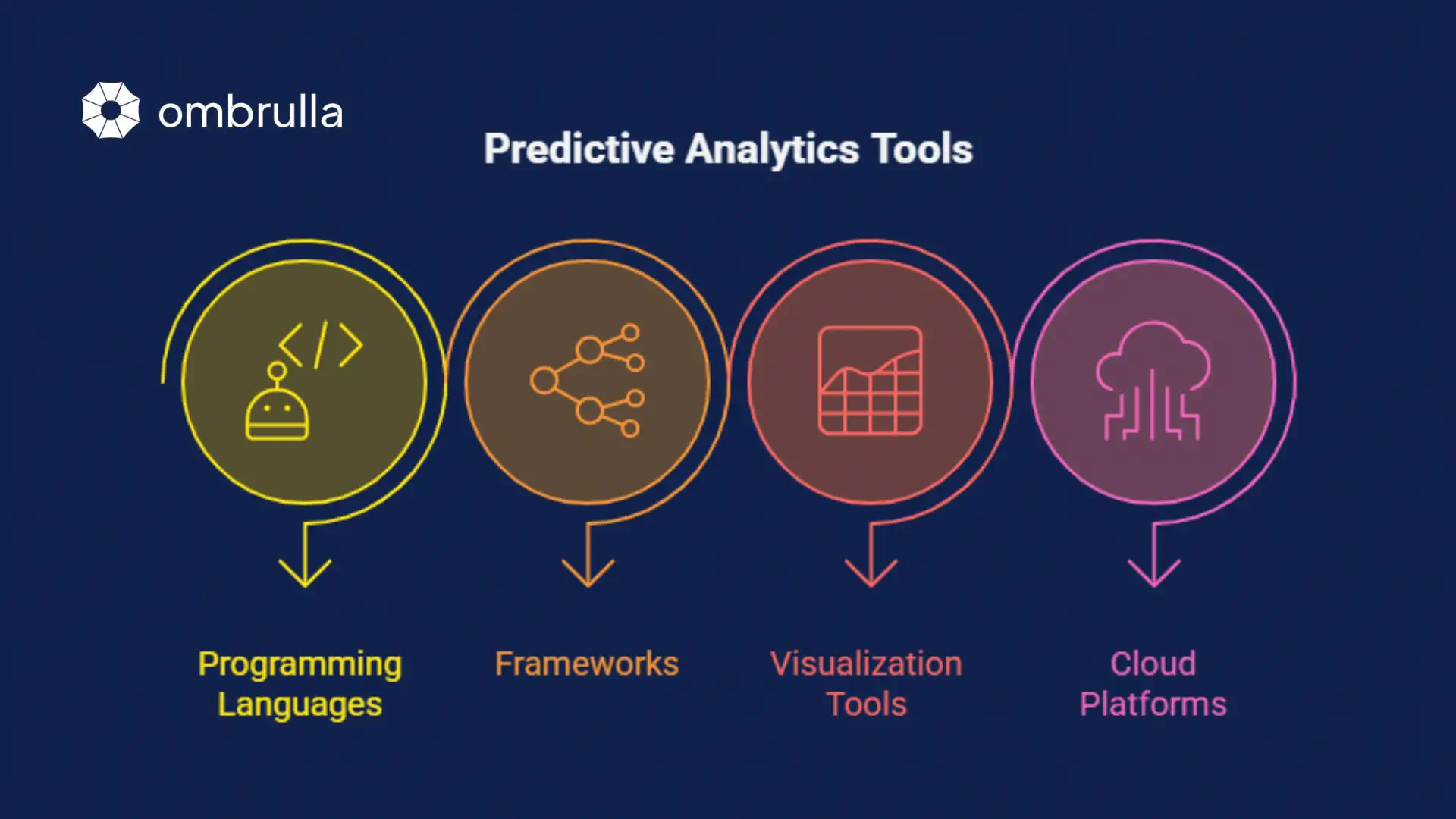Introduction to Predictive Analytics
In today’s data-driven world, companies generate massive amounts of data every second. But raw data alone does not guarantee better decisions - it needs to be turned into actionable insights. Predictive analytics does exactly that by using advanced statistical models and machine learning to forecast future outcomes. From reducing risks to increasing efficiency, predictive analytics empowers industries to stay ahead of the competition. In this blog, we’ll explore how predictive analytics works, its benefits, industries using it, real-world applications, implementation steps, and emerging trends.
What is Predictive Analytics?
Predictive analytics is a branch of advanced analytics that uses historical data, statistical algorithms, and machine learning techniques to predict future events. It goes beyond traditional descriptive analytics, which only explains what happened in the past. With predictive analytics, businesses can anticipate trends, customer behaviors, equipment failures, or market shifts with a high degree of accuracy. This foresight enables better strategic planning, proactive measures, and data-driven decision-making. Companies that leverage predictive analytics gain a strong competitive edge by acting before problems arise or opportunities are lost.
Core Components:
- •Data Collection: Gathering relevant structured and unstructured data.
- •Data Analysis: Using statistical models and machine learning algorithms.
- •Predictive Modeling: Creating models to identify patterns.
- •Deployment: Using models in real-time business processes.
How Does Predictive Analytics Work?
At its core, predictive analytics works by gathering historical data from various sources like ERP systems, IoT devices, CRM platforms, production lines, and Asset Performance Management Software. This data is cleaned, organized, and analyzed to uncover patterns and relationships that may not be visible to the naked eye. Data scientists then build mathematical models and train machine learning algorithms to recognize these patterns. Once trained, the models can process new incoming data and generate predictions or alerts automatically. This cycle continuously improves over time as models learn from new outcomes, increasing accuracy and reliability.
Key Benefits of Predictive Analytics

1.Improved Decision Making
Predictive analytics provides decision-makers with data-backed forecasts rather than gut feeling or guesswork. This means leaders can make more confident choices when allocating budgets, managing risks, or planning strategies. For example, a retailer can forecast product demand more accurately, preventing overstocking or stockouts. This reduces waste, saves costs, and ensures customers get what they want when they need it. Over time, better decisions compound to boost profitability and competitive positioning.
2.Cost Reduction
By predicting failures, downtime, or resource waste, predictive analytics helps organizations cut unnecessary expenses. In manufacturing, predictive maintenance can reduce unplanned downtime, extending the lifespan of expensive equipment. Companies can shift from reactive or scheduled maintenance to fixing issues only when data indicates a problem is likely. This saves both time and money, minimizing disruptions in production lines. These cost savings free up capital that can be reinvested in innovation or growth.
3.Risk Management
Predictive models help identify potential risks before they become serious problems. Banks use it to detect fraud by spotting unusual transaction patterns that deviate from a customer’s normal behavior. Similarly, insurance companies analyze driving data to predict accident risks and adjust premiums accordingly. By proactively managing risks, companies can strengthen compliance, reduce liabilities, and protect their brand reputation. The result is a more resilient business capable of navigating uncertainty.
4.Enhanced Customer Experience
By analyzing buying patterns and preferences, companies can personalize recommendations for each customer. Think of how streaming services suggest shows you might like or how e-commerce sites recommend products. This personalization increases customer satisfaction, loyalty, and ultimately revenue. Predictive analytics can also forecast customer churn so that businesses can act early to retain high-value clients. Overall, it creates a win-win situation for both companies and their customers.
Key Predictive Analytics Use Cases Across Industries
1. Manufacturing
• Predictive maintenance to prevent failures and improve Overall Equipment Effectiveness.
• Forecasting demand for production planning.
•Quality assurance and defect reduction.
2. Healthcare
• Predicting patient readmissions.
• Personalized treatment planning.
• Resource optimization for hospitals.
3. Retail
• Customer purchase behavior prediction.
• Inventory and supply chain optimization.
• Price optimization based on demand forecasts.
4. Finance
• Fraud detection.
• Credit risk assessment.
• Portfolio optimization.
Predictive Analytics vs Prescriptive Analytics vs Descriptive Analytics
In data-driven decision-making, analytics can be categorized into three main types: Descriptive, Predictive, and Prescriptive Analytics. Each plays a crucial role in helping organizations understand their operations, anticipate future outcomes, and take the best possible actions. While these terms are often used together, they serve different purposes in the data analytics journey. Understanding the differences will help your organization choose the right analytics strategy for informed, actionable decision-making.

1.Descriptive Analytics: What happened?
Descriptive analytics focuses on summarizing historical data to understand what has already occurred within an organization. It uses techniques like data aggregation, data mining, and data visualization to generate insights from past events and trends. For example, sales reports, website traffic analysis, and monthly financial summaries are forms of descriptive analytics. It helps stakeholders understand key performance indicators (KPIs), discover patterns in data, and assess the effectiveness of past strategies. While descriptive analytics provides clarity on past performance, it does not explain why trends occurred or predict future outcomes.
2.Predictive Analytics: What will happen?
Predictive analytics goes a step further by using historical data to forecast future outcomes. It leverages statistical models, machine learning algorithms, and data mining techniques to identify trends, patterns, and potential future events. For example, it can predict customer churn, forecast demand for a product, or anticipate machine failures in manufacturing environments. This enables businesses to prepare in advance, make proactive decisions, and reduce risks associated with uncertainty. Predictive analytics is a powerful tool for industries seeking to optimize operations, enhance customer experiences, and stay ahead of market trends.
3.Prescriptive Analytics: What should we do about it?
Prescriptive analytics takes predictive insights further by suggesting the best actions to achieve desired outcomes. It combines machine learning, optimization algorithms, and business rules to recommend specific actions based on predicted scenarios. For instance, if predictive analytics indicates a potential drop in customer demand, prescriptive analytics might suggest adjusting production schedules or launching targeted promotions to maintain sales. It helps organizations simulate various decision paths and understand the impact of each choice before implementation. By providing actionable recommendations, prescriptive analytics empowers businesses to optimize resources, maximize efficiency, and align operations with strategic goals.
How Predictive Analytics Works: A Step-by-Step Process
Implementing predictive analytics requires careful planning and the right technology stack. First, companies must define clear goals—what do they want to predict and why? Next, they gather and integrate data from all relevant sources, ensuring it’s clean and high-quality. Then, data scientists build and train predictive models using machine learning tools. Finally, the models are tested, deployed, and continuously monitored to ensure they deliver accurate results over time.

1. Defining Objectives
Before building predictive models, organizations must clearly define what they want to predict and why it matters to their business. This step ensures alignment with organizational goals, whether it is forecasting customer demand, predicting equipment failures, or anticipating market trends. By defining objectives, businesses can identify the KPIs that will measure the success of the predictive analytics initiative. A well-defined objective provides direction and focus for the entire predictive analytics project, maximizing return on investment.
2. Data Collection and Preparation
Once objectives are set, the next step is gathering relevant data from all necessary sources, including ERP systems, IoT devices, CRM platforms, and external databases. The collected data is then cleaned, transformed, and organized to eliminate inconsistencies, duplicates, and inaccuracies, ensuring high-quality data for analysis. This stage may also involve handling missing values, outlier detection, and data normalization to improve model performance. A robust data preparation phase ensures that the predictive models are built on a reliable and accurate foundation.
3. Data Analysis and Feature Engineering
During this phase, data scientists explore the cleaned data to uncover hidden patterns and relationships that could impact predictions. Feature engineering is performed to create new variables or modify existing ones to improve the predictive power of the models. For example, combining date and time fields into cyclic features or deriving ratios between two variables can reveal valuable insights. Effective data analysis and feature engineering are critical for enhancing model accuracy and providing deeper business insights.
4. Model Building
After preparing the data and engineering relevant features, predictive models are built using machine learning algorithms tailored to the specific use case. Data scientists may use regression, classification, clustering, or time-series forecasting models depending on the objective. Multiple algorithms are often tested to identify the best-performing model using metrics aligned with business goals. This phase transforms raw data into a predictive engine capable of forecasting future trends, behaviors, or events.
5. Model Validation
Once the models are built, they need to be rigorously tested to ensure they deliver accurate and reliable predictions. Validation involves using test datasets and cross-validation techniques to evaluate the model’s performance under different scenarios. Metrics such as accuracy, precision, recall, F1-score, and RMSE are used to measure effectiveness based on the prediction type. Model validation helps businesses ensure confidence in the results before deploying the models into live environments.
6. Deployment and Monitoring
After validation, the predictive models are deployed into production environments to generate real-time or batch predictions as part of business processes. This allows decision-makers to act on insights to improve operations, enhance customer experiences, or reduce risks. Continuous monitoring of the models is essential to detect performance degradation due to changes in market conditions, customer behavior, or operational processes. Ongoing retraining and fine-tuning ensure that predictive analytics continues to deliver accurate, actionable insights over time.
Tools and Technologies Used in Predictive Analytics
Predictive analytics requires a robust ecosystem of tools and technologies to collect, clean, analyze, visualize, and operationalize data-driven predictions effectively. These tools empower data scientists, analysts, and business leaders to build and deploy predictive models seamlessly across industries.

Programming Languages: Python, R
- • Python is the most popular programming language for predictive analytics due to its simplicity, readability, and a vast collection of libraries for data analysis and machine learning. Libraries such as Pandas (for data manipulation), NumPy (for numerical computations), Matplotlib and Seaborn (for visualization), and Scikit-learn (for machine learning) make Python a go-to choice for building predictive models efficiently.
- •R is a statistical programming language known for its powerful data analysis and visualization capabilities. It is extensively used in academic and research environments for predictive modeling due to its vast range of packages like caret, randomForest, and forecast. R’s advanced statistical capabilities enable in-depth exploration of data distributions, hypothesis testing, and model evaluation, making it ideal for complex predictive analytics tasks.
- •Both Python and R support integration with big data platforms and can connect with visualization tools to operationalize models, allowing seamless workflows in predictive analytics pipelines.
Frameworks: TensorFlow, Scikit-learn
- •TensorFlow is an open-source deep learning framework developed by Google, ideal for building advanced machine learning and neural network models for predictive analytics. It allows scalable model training across CPUs and GPUs and supports deep learning capabilities such as sequence modeling, image recognition, and time-series forecasting for large datasets.
- •Scikit-learn is a user-friendly machine learning library in Python that provides a wide range of algorithms for regression, classification, clustering, and dimensionality reduction. It is widely used for building and evaluating predictive models quickly, with functionalities for data preprocessing, model selection, and pipeline management.
- •These frameworks provide the computational backbone for developing accurate predictive models, enabling experimentation and scalable deployment in production environments.
Visualization Tools: Power BI, Tableau
- •Power BI, developed by Microsoft, is a business intelligence tool that allows users to visualize and share insights from predictive models interactively. It supports real-time dashboarding, integration with Python and R scripts, and advanced analytics features, making it easier for stakeholders to interpret predictive results.
- •Tableau is another leading data visualization tool that helps convert predictive insights into easy-to-understand visuals through interactive dashboards and storytelling capabilities. Tableau allows integration with R and Python to bring predictive analytics into visual dashboards, enabling non-technical users to engage with predictive data.
- •These tools transform complex predictive results into actionable, clear visuals, facilitating better decision-making across all business levels.
Cloud Platforms: AWS, Azure ML, Google Cloud AI
- •AWS (Amazon Web Services) offers predictive analytics services through Amazon SageMaker, enabling scalable training, deployment, and management of machine learning models. AWS also integrates with big data services like Amazon Redshift and Kinesis to handle data ingestion for predictive workflows.
- •Azure Machine Learning by Microsoft provides a comprehensive platform for building, deploying, and managing predictive models in the cloud, with drag-and-drop interfaces, AutoML capabilities, and integration with Power BI for visualization.
- •Google Cloud AI Platform offers scalable tools for building, deploying, and monitoring machine learning models using TensorFlow and other frameworks, enabling advanced predictive analytics pipelines in the cloud.
- •These cloud platforms democratize predictive analytics by providing scalable computing resources, secure data management, and integration with analytics and visualization tools, making predictive analytics accessible to businesses of all sizes.
Challenges in Implementing Predictive Analytics
Despite its benefits, predictive analytics has challenges companies must tackle. Data quality is a major concern - inaccurate or incomplete data leads to poor predictions. Building models requires skilled data scientists and robust tools, which can be expensive and time-consuming. There’s also the risk of data privacy violations if sensitive information isn’t handled securely. Lastly, predictive models must be updated regularly to stay accurate as markets and behaviors change. Companies must address these hurdles for successful implementation.
- •Data quality and integration issues.
- •Lack of skilled personnel.
- •Resistance to change.
- •Complexity in interpreting results.
- •Data privacy and security concerns.
The Future of Predictive Analytics: Shaping Smarter, Resilient Businesses
Predictive analytics is not just a passing trend; it is evolving into a critical driver of smarter, faster, and more responsible business decisions. As technology advances, predictive analytics will seamlessly integrate into everyday business workflows, empowering leaders to act with precision and confidence.
1. AI and Deep Learning Integration: Smarter, More Accurate Predictions
Advanced AI and deep learning models will take predictive analytics to the next level, offering businesses unparalleled accuracy and insights. By analyzing complex patterns in massive datasets, these models can forecast customer behaviors, market shifts, and operational anomalies with remarkable precision. For example, manufacturers can predict equipment failures days in advance, while retailers can understand customer preferences down to micro-segments. This empowers leaders to make decisions that are not just reactive but proactively shape business outcomes.
2. Edge Analytics: Real-Time Decisions, Anywhere
Predictive analytics is moving closer to the action with edge computing, allowing businesses to run predictive models directly on devices at the source of data. Whether on factory floors, remote oil rigs, or within delivery fleets, insights can now be generated and acted upon instantly without waiting for data to travel back to the cloud. This enables real-time monitoring and rapid decision-making, which is essential for time-sensitive operations and safety-critical environments. Businesses gain agility, faster response times, and reduced data latency, driving operational excellence.
3. Automated Machine Learning (AutoML): Making Predictive Analytics Accessible
Traditionally, predictive analytics required skilled data scientists and extensive model tuning, creating a barrier for many businesses. AutoML is transforming this landscape by automating model building, testing, and deployment, allowing business analysts and teams to generate predictive models without deep technical expertise. This democratization of predictive analytics means companies can harness advanced insights faster, reduce dependency on limited expert resources, and empower teams to drive data-driven initiatives independently. It’s about making predictive power accessible to every part of the business.
4. Explainable AI (XAI): Building Trust in Predictions
As predictive models become more complex, understanding how predictions are made becomes crucial for business leaders to trust and act on them. Explainable AI (XAI) provides transparency by revealing which factors influence predictions, allowing leaders to interpret and validate model outputs confidently. This transparency fosters trust across teams and simplifies compliance with regulations requiring interpretability. With XAI, businesses can confidently integrate predictive analytics into critical decision-making processes, ensuring accountability and informed actions.
5. Sustainability Analytics: Driving Environmental Responsibility
The future of predictive analytics will play a vital role in helping businesses achieve their sustainability goals. By predicting energy consumption patterns, waste generation, and supply chain emissions, organizations can proactively reduce their environmental footprint. For example, predictive models can optimize energy usage in production lines, forecast resource needs to minimize waste, and enable smarter logistics planning to reduce fuel consumption. This is not just about compliance but building a responsible, sustainable business that resonates with environmentally conscious customers and stakeholders.
Case Studies: Predictive Analytics in Action
Manufacturing: Predictive Maintenance
A leading automotive manufacturer reduced unplanned downtime by 30% using predictive maintenance models, saving millions annually.
Banking: Fraud Detection
A financial institution implemented predictive models to detect fraudulent transactions, reducing fraud loss by 40%.
Retail: Demand Forecasting
A retail chain improved inventory turnover by 25% using predictive analytics, reducing stockouts and overstocking.
Conclusion: Take the Leap into Predictive Analytics
Predictive analytics offers an actionable path to transforming your organization’s efficiency, cost structure, and decision-making accuracy. It is no longer a luxury but a necessity for organizations looking to stay competitive in the data-driven era.
Whether you are in manufacturing, retail, healthcare, finance, or energy, predictive analytics can unlock the next level of operational excellence for your business. Ready to harness predictive analytics for your business? Contact us today for a free consultation and discover how predictive analytics can transform your operations.





